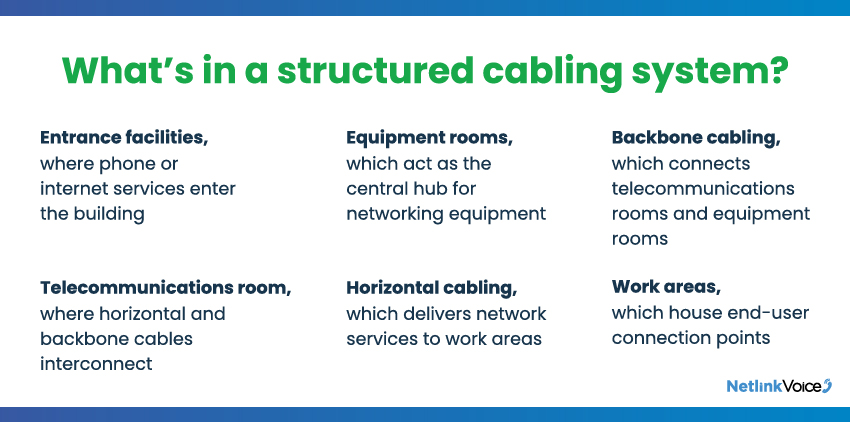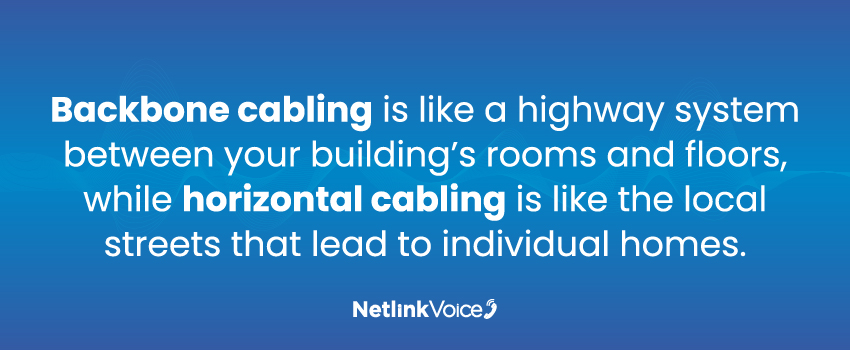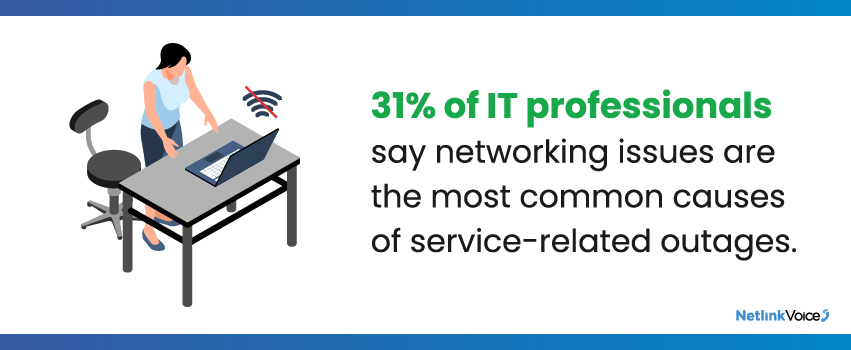Network downtime cost large organizations an average of $9,000 per minute in 2024.1 Unfortunately, the risk of unplanned outages increases when your cabling infrastructure is disorganized. Network issues become harder to fix, simple equipment changes turn into complex projects, and your IT team spends hours managing problems that could be prevented.
Structured cabling solves these common networking headaches by replacing inefficient cable setups with an organized, interconnected wiring system. Read on to learn everything you need to know about structured cabling systems – what they are, what they should include, and how they can benefit your business.
What Is Structured Cabling? A Brief Definition
Structured cabling offers a standardized approach to designing and installing communication systems. While traditional point-to-point cabling often results in a tangled web of wires, structured cabling systems are a comprehensive framework that simplifies cable management.
Structured Cabling vs Point-to-Point Cabling
Traditional point-to-point cabling connects devices directly to one another or to network hardware with individual patch cords. This approach can work in small environments, but as your business grows, so does the tangle of cables. Over time, it becomes harder to trace connections, make changes, or troubleshoot issues without disrupting something else.
Structured cabling takes a different approach. Instead of running cables directly between devices, hardware ports connect to patch panels and backbone cabling that follow a standardized design. Moves, adds, and changes happen at the patch panel rather than at every switch or endpoint, keeping your environment organized and easier to manage.
The difference becomes obvious when it’s time to troubleshoot or expand. In a point-to-point setup, adding a new workstation or replacing a switch can require pulling new cable runs and sorting through a maze of connections. With structured cabling, your IT team can quickly identify the right port, make the change, and confirm that everything else remains untouched. The result is a cleaner layout, better airflow around your equipment, and a lower risk of downtime caused by accidental unplugging or cable strain.
The 6 Components Of Structured Cabling
Structured cabling infrastructure is made up of six key components that work together to create an interconnected communication infrastructure.

Entrance Facilities
This is the point where your external telecommunications services, such as internet or phone lines, enter your building. The entrance facilities provide a secure environment for the incoming cabling and wiring consolidation points.
Entrance facilities include several important elements, including:
-
- Network connection points for service provider integration
-
- Patch panels for effective cable management
-
- Equipment racks for hardware installation
-
- Protection devices for grounding and shielding
-
- Lightning protection systems for safety
-
- Power supplies for associated equipment
While service providers are typically responsible for determining the specific cables used, your facility needs appropriate space and environmental controls to house this equipment safely.
Equipment Room
The equipment room serves as the central point for your structured cabling system. It houses essential network equipment like:
-
- Patch panels for backbone and horizontal cable connections
-
- Network switches and routers
-
- PBX systems for voice communications
-
- Servers and related network equipment
-
- Cable management systems
The equipment room also provides the environmental controls, power, and security needed to ensure the reliable operation of your networking equipment.
Backbone Cabling
Also known as vertical cabling, backbone cabling connects the telecommunications rooms and equipment rooms within a building. It supports several cable types, including:
-
- 100-ohm twisted-pair cables
-
- Category 3 for basic voice communications
-
- Category 5e for standard data transmission
-
- Category 6 for improved network performance
-
- Category 6a for advanced applications
-
- 100-ohm twisted-pair cables
-
- Fiber optic cables
-
- Multimode fiber (850nm laser-optimized 50/125 micrometer) for most applications
-
- Alternative options: 62.5/125 μm and 50/125 μm
-
- Single-mode fiber for extended distances
-
- Fiber optic cables
The backbone cabling system is responsible for providing high-speed data transmission between the different areas of your facility.
Telecommunications Room
Telecommunication rooms are the designated spaces where the horizontal and backbone cables interconnect. This may be an actual room or a smaller space within a room, referred to as a telecommunications enclosure. The telecommunications room (or enclosure) provides the necessary cross-connect and patch panel functionality to facilitate the connectivity between the different subsystems of your structured cabling system.
Horizontal Cabling
The horizontal cabling subsystem delivers voice, data, and other network services to the individual work areas within the facility. It supports various cable types, such as:
-
- Cat5e, Cat6, or Cat6a twisted pair cables
-
- Two-fiber multimode optical fiber
-
- Two-fiber single-mode optical fiber
Horizontal cabling also includes standardized components like patch panels, patch cords, and consolidation points for connecting multiple devices.
Work Area
The work area is the final destination of a structured cabling system, where your employees’ end-user devices connect to the network. Work areas include wall outlets, patch cables, and any other necessary components to connect the user and the network infrastructure.

Key Advantages Of A Structured Cabling System
Investing in structured cabling offers several advantages that can enhance your business operations. These include:
Improved Scalability
Structured cabling systems can accommodate growth and changes within your organization, whether you need to add more workstations, expand to another location, or integrate new technologies. The modular design lets your network infrastructure evolve naturally alongside your business needs.
The system’s standardized architecture also supports multi-vendor equipment integration. You have the freedom to choose the best solutions for your needs, as you’re not locked into specific manufacturers or technologies. When new technologies emerge, your cabling infrastructure can adapt without requiring a complete overhaul.
Greater Reliability
Structured cabling solutions include redundancy and fail-safe measures to improve overall system reliability. They also eliminate many common points of failure found in traditional cabling setups. Each connection point follows strict installation guidelines and testing protocols, ensuring consistent performance across your entire network. Plus, organized cable routing protects against physical damage, while proper cable management prevents signal interference.
Easy Troubleshooting & Maintenance
A 2024 survey found that networking issues are the most common causes of service-related outages, according to 31% of the IT professionals surveyed.2 Since structured cabling systems use standardized components, they’re easier to manage and maintain than traditional network cabling. This orderly setup also simplifies troubleshooting, making it easier to catch and address issues before they can impact your business operations.
A structured cable system must also follow documentation standards to create a clear roadmap of your network infrastructure. Each cable run, connection point, and equipment location is appropriately labeled and mapped, allowing your IT team to trace network connections and resolve issues quickly.
Future-Proofing
Structured cabling accommodates the current and future needs of modern businesses. Its high bandwidth capacity supports applications like AI, virtual reality, and advanced videoconferencing, so you can leverage without having to overhaul your entire system.
Cost Savings
Although the initial investment in structured cabling is typically higher than a traditional point-to-point approach, the long-term benefits can reduce operational costs. Since the system’s organized approach reduces the time required for moves, adds, and changes (MACs), your IT team can complete these tasks more efficiently.
Structured cabling systems also extend the lifespan of your cabling infrastructure, spreading your initial investment over a longer period and reducing the frequency of system-wide updates.

Real-World Use Cases For Structured Cabling
Structured cabling is not just a technical best practice. It is the foundation that supports the way modern organizations work, collaborate, and serve customers every day.
Modern Offices & Hybrid Work
In today’s offices, employees depend on reliable connectivity for everything from video conferencing and cloud applications to softphones and collaboration tools. Structured cabling gives you consistent performance at desks, in meeting rooms, and across shared spaces, so your hybrid workforce can move between locations without worrying about dropped calls or unstable connections.
Multi-Site & Campus Environments
Organizations with multiple buildings or locations need a consistent way to connect teams and systems. Structured cabling provides a repeatable framework for wiring offices, campuses, and remote sites, making it easier to extend services, standardize equipment, and maintain predictable performance as you grow.
Security & Building Systems
Modern security and building systems often share the same network infrastructure as your IT environment. Video surveillance, access control, alarms, and other building technologies rely on stable connections and enough bandwidth to operate effectively. A well-designed structured cabling system helps these systems stay online and integrated, instead of running on separate, ad hoc wiring that is hard to support.
Structured Cabling Standards & Compliance
Structured cabling is built on a set of industry standards that define how systems should be designed, installed, and tested. Following these standards is essential for long-term performance and compatibility.
The Standards Behind Structured Cabling
Organizations such as the Telecommunications Industry Association (TIA) and the International Organization for Standardization (ISO) publish specifications for cabling topology, cable types, performance levels, and testing requirements. Standards like ANSI/TIA-568 outline how to design structured cabling systems for commercial environments so they can reliably support current and future network applications.
Why Standards Compliance Matters
When your cabling system adheres to recognized standards, you gain more than a tidy wiring closet. Standards compliance helps ensure that cables, connectors, and network hardware from multiple vendors work together as intended. It also makes it easier to test and certify your installation, document performance, and troubleshoot issues using familiar methods and tools.
How Netlink Voice Designs To Industry Standards
Netlink Voice uses standards-based design principles for structured cabling projects, from the layout of equipment rooms and pathways to the selection of cable categories and terminations. By aligning our work with industry best practices, we help you build a network infrastructure that is easier to maintain, simpler to upgrade, and better prepared to support the technologies your business will rely on next.
Structured Cabling Installation: 5 Things To Consider
Before installing a structured cabling system, it’s important to look at a few key areas to make sure your investment delivers reliable performance and room to grow.
1. Facility Layout
Start with your building’s floor plan. Understanding where workspaces, equipment rooms, conference rooms, and other critical areas are located helps you plan cable pathways for optimal coverage. A clear layout makes it easier to avoid bottlenecks, reduce cable congestion, and keep pathways accessible for future changes.
2. Business Requirements
Next, consider how your teams actually use the network. Think about the number of users, the types of devices they rely on, and the applications that are critical to daily operations. Bandwidth-hungry tools like video conferencing, cloud services, and IP voice will influence your cabling choices and capacity planning.
3. Building Size & Structure
The physical characteristics of your building will also shape your cabling design. The number of floors, the presence of vertical risers, ceiling types, and existing pathways all affect how complex the installation will be. Accounting for these details early helps you avoid surprises once work begins.
4. Future Growth Goals
Your structured cabling system should support where your business is going, not just where it is today. If you expect to add more employees, open new departments, or adopt new technologies, plan for that growth in your cabling design. Leaving capacity in pathways and choosing media that can handle higher speeds will make future upgrades much simpler.
5. Environmental Factors
Environmental conditions can impact the long-term performance of your cabling. Equipment rooms and telecommunications spaces should be properly cooled, ventilated, and protected from dust and moisture. Stable temperature and humidity levels help protect both passive cabling and active network hardware.
If you’re not sure where to begin, partnering with an experienced structured cabling provider can help you translate these considerations into a practical design that supports your current needs while also future-proofing your network.
Structured Cabling, Wireless Networks & IoT
Wireless networks may feel cable-free to your users, but behind every access point and controller is a physical connection. Structured cabling is what keeps those wireless networks stable, consistent, and ready for growth.
Why Wireless Still Depends On Cabling
Wi-Fi access points, wireless controllers, and small-cell systems all depend on a reliable wired backbone. Poor-quality cabling, inconsistent terminations, or overloaded pathways can create performance bottlenecks that show up as slow or unreliable wireless service. When your cabling follows a structured design, your wireless infrastructure has the bandwidth and stability it needs to support high-density environments.
Designing For Wi-Fi & Private Networks
Planning for wireless coverage is not only about radio placement and signal strength. It also involves ensuring that each access point location has the right cabling, power, and network capacity. A structured cabling system makes it easier to place access points where they are actually needed, connect them back to the core, and upgrade them over time without rebuilding your entire plant.
Preparing For IoT Growth
The number of connected devices in your environment is only going to increase. Sensors, smart lighting, environmental controls, security devices, and other IoT endpoints all depend on a solid network foundation. Structured cabling provides a unified infrastructure for these systems, reducing the need for separate wiring projects and making it easier to integrate new technologies as they become part of your operations.
Power over Ethernet (PoE) & Structured Cabling
Power over Ethernet (PoE) allows you to deliver both data and electrical power over a single network cable. For many modern devices, that makes the cabling plant even more important.
What Is Power over Ethernet?
With PoE, compatible switches or midspan injectors deliver low-voltage power across the same twisted-pair cabling that carries network traffic. This approach eliminates the need for separate power outlets at every endpoint, making it easier to deploy and relocate devices wherever they are needed in your facility.
Common PoE Use Cases
Many familiar technologies already rely on PoE, including IP phones, wireless access points, security cameras, and access control devices. As PoE standards evolve, more equipment can be powered this way, including advanced cameras, multi-radio access points, and even certain building systems.
Designing Your Cabling For PoE
Not every cabling system is designed with PoE in mind. Higher-power PoE applications place additional demands on cable performance, bundling, and heat dissipation. A structured cabling system that uses appropriate cable categories, proper installation practices, and thoughtful pathway design helps ensure your network is ready for current and future PoE requirements, without sacrificing reliability or safety.
Structured Cabling System FAQs
How do I know if my business needs structured cabling?
If you are experiencing frequent network issues, planning an office expansion, adding more devices, or struggling with messy cabling that is hard to trace, it is a strong sign that a structured cabling system could help. A short assessment can quickly reveal whether your current setup is limiting performance or growth.
Does structured cabling only matter for large enterprises?
No. Small and midsize organizations also benefit from standardized cabling. Even if you operate on a single floor today, a structured cabling system makes it easier to add new workstations, upgrade your network hardware, or support new applications without revisiting the entire wiring plant.
Will I need to replace all my existing cabling?
Not always. In some cases, existing cable runs can be reused or incorporated into a new structured design, especially if they already meet current performance requirements. During the planning process, a structured cabling provider can identify what can be kept, what should be upgraded, and how to phase changes to minimize disruption.
How long does a structured cabling installation take?
Project timelines depend on the size of your facility, the complexity of your network, and whether the building is occupied during installation. A good provider will build a phased plan, schedule work around your operations, and clearly communicate how the project will impact your users.
Which structured cabling component provides connectivity?
All six structured cabling components work together to provide connectivity, but the horizontal cabling and work area are where users feel it most. Horizontal cabling runs from the telecommunications room to outlets in each workspace, and the work area includes the jacks, patch cords, and devices that plug into those outlets. Backbone cabling, equipment rooms, and entrance facilities then connect those local links back to your core network and external services.
Why is structured cabling important?
Structured cabling is important because it turns your network into a predictable, scalable system instead of a collection of one-off cable runs. By following a standardized design, you reduce downtime, simplify troubleshooting, and make moves, adds, and changes much easier to manage. It also gives you a solid foundation to support faster speeds, new applications, wireless networks, and PoE devices without constantly rebuilding your wiring from scratch.
Why Partner With Netlink Voice For Your Structured Cabling System
The role of structured cabling extends beyond proper cable management. As businesses increasingly rely on emerging solutions like cloud services and AI, implementing a well-designed structured cabling system is a must for staying competitive while protecting your technology investments.
Ready to transform your network infrastructure? Netlink Voice can help. Our infrastructure solutions cover everything from structured cabling system design to installation, including LAN connectivity, fiber optic backbones, and integrated security solutions like video surveillance and access control. Most importantly, we provide responsive support throughout your project to ensure your network infrastructure truly serves your business goals.
Reach out to the Netlink Voice team today to upgrade to a hassle-free structured cabling system.
Sources:

